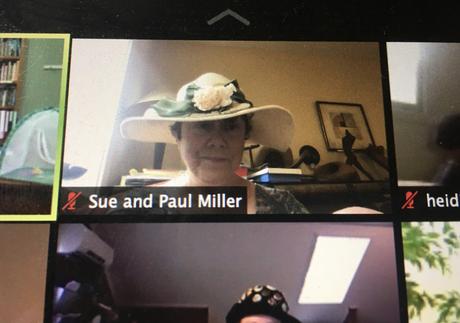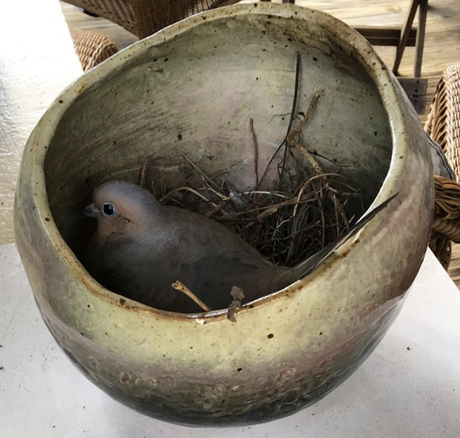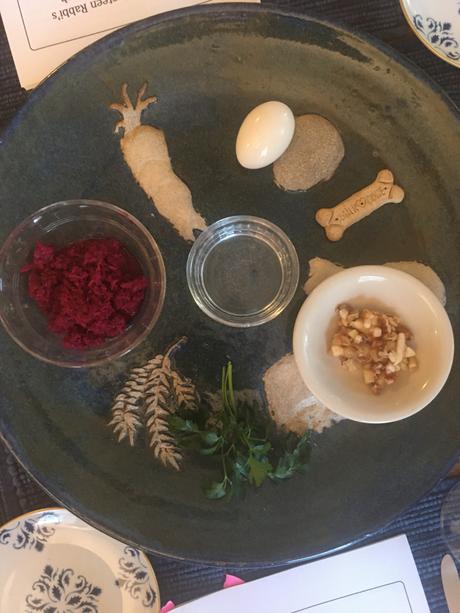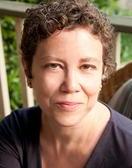 In my Easter bonnet. On mute.
In my Easter bonnet. On mute.
We made it through Holy Week and Passover. Dayenu.
Dayenu is everyone's favorite song at the Seder. It means, "it would have been enough." We use it to express gratitude. Even in this harrowing time, we need gratitude. (We also need big helpings of courage, and righteous anger, and passion for social justice, all themes of the seder).
Since I last posted here, the pandemic has gotten very close and real. I know people who have died, are sick, were separated from dying loved ones, have not been able to mourn these losses with traditional ritual.
We are locked down. We are masked. We are anxious, depressed, at times terrified.

Still, I have the privilege of being able to feel gratitude:
For the cherry blossoms and daffodils. Dayenu.
For the mourning doves nesting on our front porch in a ceramic pot my mother made. Dayenu.
For the sweet antics of the rescue puppy we adopted just before the pandemic hit DC. Dayenu.
For my years spent in Brazil cultivating a love for rice and beans, which help me live from my pantry now. Dayenu.
For my sister who runs a homeless healthcare clinic in New York City, and all the other workers risking themselves to try to save others. Dayenu.
And for Tony Fauci, that brilliant mensch, whom I interviewed many times while covering the HIV/AIDS epidemic during my years as a science reporter. Dayenu.
And, now more than ever, I feel deep gratitude for my interfaith families community. Just as Holy Week and Passover and the Sikh holiday of Vaisakhi and Ramadan were approaching, we were forced to scramble to make the transition to online religious and spiritual gatherings. Clergy now have to be tech wizards, innovating to conjure up the sounds and smells and tastes of these holidays, while attempting to maintain a sense of community for people in tiny pixellated squares. (Teachers, including my daughter, are faced with the same awesome task and steep learning curve right now).

One silver lining of our abrupt and forced transition to online religious and spiritual community, is that anyone with a computer or smartphone and the link can join in. As someone who loves ritual, I was able to zoom into many different communities in the past week, experiencing different seders, and different Holy Week services. At each of those celebrations, we were joined by people from across the country and the globe for the first time. Dayenu. And I had these diverse Jewish and Christian experiences, without having to drive to the homes of relatives in multiple states (as much as I fervently wish I could do that right now).
Historically, I have not always found Easter and Holy Week comfortable, as a Jew. More like, complicated. But once again this year, celebrating with the Interfaith Families Project of Greater Washington DC, in a service created by and for interfaith families, felt glorious. I could relax the part of my brain on alert for supersessionist ideas or language. Instead, the beauty of Easter's metaphor, of renewal, of resurrection, shone through in the time of the pandemic, with over 100 families zooming in. In our community, Easter traditions include singing Morning Has Broken (with music by a Christian who became a Muslim), and Lord of the Dance ( a Christian song inspired in part by a Hindu deity), as well as more traditional Easter hymns.
Among academics of religion today, the trend has been to repudiate the idea-the metaphor-that all religions are different paths up the same mountain. Instead, the dominant paradigm now is that each religion is a separate mountain, with different goals. I am glad I am not trying to earn tenure right now, because every time I experience interfaith community, I disagree with my heart and soul. I feel we share the mountain, just as we share the globe.
The mountain is the human condition. And on this shared mountain, the slope feels particularly steep right now. How do we persevere through pandemics and plagues? How do we cultivate community and compassion? Each religion and culture develops different strategies, different rituals, different liturgies. (For those in academia, yes, I am forever #TeamHustonSmith, #TeamKarenArmstrong. Apologies to friends on #TeamStephenProthero). No one said all religions are the same-or anyways not Huston Smith, not Karen Armstrong, and not me. If they were all the same, why would I need a life enriched by both religions in my heritage, the sibling religions of Judaism and Christianity?
Both Passover and Easter include the egg as a symbol. The mourning dove lays exactly two eggs. On my front porch, which represents the edge of the permissible world for us right now in lockdown, those eggs are due to hatch any day. Mourning seems appropriate in a pandemic. And doves feel like a hopeful sign, as they were for Noah. The doves (the male and female take turns on the nest) are hunkered down. They have adapted to us walking inches from their home, and even to the bark of our untamed puppy. When they hatch, I will feel another small moment of Dayenu.
It will have to be enough.
Journalist Susan Katz Miller is an interfaith families speaker, consultant, and coach, and author of Being Both: Embracing Two Religions in One Interfaith Family (2015), and The Interfaith Family Journal (2019). Follow her on twitter @susankatzmiller.
